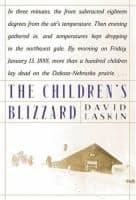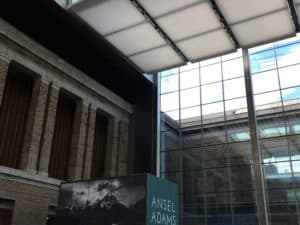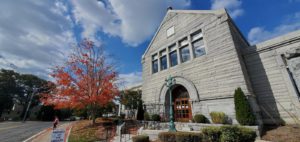 After watching author Eric J. Dolin’s presentation of A Furious Sky: The Five-Hundred-Year History of America’s Hurricanes at the Morrill Memorial Library this past February, I recalled my childhood fascination with blizzards (if you missed this fantastic program, you can catch it on YouTube here. This fascination really began with reading the Little House on the Prairie book series, which I read several times over from third grade on up. I recently re-read Wilder’s blizzardy extravaganza The Long Winter, which I discovered to be the second title; I read somewhere that the original title was The Hard Winter, but the publishers didn’t want to make it too scary for the children. Perhaps they missed the part in the book where the cattle’s mouths froze to the ground and then smothered them. The book, as you can imagine, is rife with cold, storms, and the privations that go along with living in a frontier town. Growing up, I thought that these books were works of nonfiction; I have since learned that the series is considered a fictionalized memoir.
After watching author Eric J. Dolin’s presentation of A Furious Sky: The Five-Hundred-Year History of America’s Hurricanes at the Morrill Memorial Library this past February, I recalled my childhood fascination with blizzards (if you missed this fantastic program, you can catch it on YouTube here. This fascination really began with reading the Little House on the Prairie book series, which I read several times over from third grade on up. I recently re-read Wilder’s blizzardy extravaganza The Long Winter, which I discovered to be the second title; I read somewhere that the original title was The Hard Winter, but the publishers didn’t want to make it too scary for the children. Perhaps they missed the part in the book where the cattle’s mouths froze to the ground and then smothered them. The book, as you can imagine, is rife with cold, storms, and the privations that go along with living in a frontier town. Growing up, I thought that these books were works of nonfiction; I have since learned that the series is considered a fictionalized memoir.
Coming to terms with the fact that the series was somewhat loosely autobiographical rather than gospel truth was like realizing for the first time that one’s parents are human. I read about how Laura’s dog Jack actually just went off into the sunset with their ponies Pet and Patty (they were so attached to one another) when Pa sold them to the cowboys, as opposed to Laura finding him stiff and cold in his doggy box next to Ma’s cookstove, as portrayed in the books. That scene always tore me apart, and it wasn’t even real! I admit, I felt somewhat cheated, but also kind of relieved. Jack was such a good and faithful dog that he deserved a good ending.
It was this fictionalizing of the truth that led me to do some research on my own about the Blizzard of 1888 in the Northwest Plains of the United States. This storm was called “The Schoolchildren’s Blizzard,” because it claimed over 200 victims, most of whom were children. The storm seemingly came out of nowhere and was described as a “sheet of snow” going faster than a person could run, and “slamming into the building… shaking and almost tearing it to pieces.” Many mistook the roaring sound of the storm for a freight train. Some teachers (a lot of them barely teenagers themselves) made the children stay put, and some let them go home. This last decision was usually made out of necessity; the building was damaged by the storm, or they were out of coal (very little wood on hand to burn on the prairie – it was either coal or hay) and faced sure demise if they stayed where they were. It’s a horrifying thought, being responsible for making such a decision as an adult, never mind as a teenager! Alas, many made the wrong decision and paid with their lives and the lives of their students.
In my search for information about the Blizzard of 1888, I found two non-fiction books, one of which was David Laskin’s well-researched The Children’s Blizzard, and the other a book called In All Its Fury: the Great Blizzard of 1888 by W.H. O’Gara, which contains the actual eyewitness testimony of folks living in Nebraska and the Dakota territories during the time of the blizzard. Laskin writes not only of the storm, but goes into great detail about why it was so deadly. He traces the storm through the book from beginning to end by studying old weather maps and predictions made by the Army Signal Corps, the precursors of the National Weather Service. Laskin unfolds a story of mistakes and finger-pointing, this history of weather prediction illustrating the terrible aftermath of an incorrect or delayed weather report. A truly chilling aspect of the story is manifested as Laskin follows several victims’ journey through hypothermia and its after effects. For some, this is amputation, and for others, death.
In the spirit of fictionalized memoirs, I can recommend Melanie Benjamin’s book, also titled The Children’s Blizzard, as a good historical fiction novel. Benjamin dips into the same information that Laskin wrote of, and cleverly focuses her story on just a few characters, enabling the story to flow. Benjamin gives a haunting portrayal of what life was like for the many immigrants that came to this country for “free land” and a chance to live the American Dream.
David Laskin ends his book The Children’s Blizzard with this appropriate quote: “The blizzard of January 12, 1888… came without warning, the pioneers learned that the land they had desired so fervently and had traveled so far to claim wasn’t free after all. Who could have predicted that the bill would arrive with a sudden shift of wind in the middle of a mild January morning?”
Carla Howard is the Senior Circulation and Media & Marketing Assistant at the Morrill Memorial Library in Norwood, MA. Look for her article in the April 1, 2021 issue of the Transcript & Bulletin.



